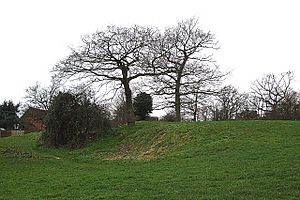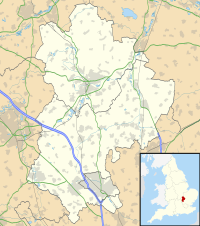Flitwick Castle facts for kids
Quick facts for kids Flitwick Castle |
|
|---|---|
| Flitwick, Bedfordshire, England | |

Flitwick Castle earthworks, 2007
|
|
| Coordinates | 51°59′51″N 0°30′18″W / 51.99752°N 0.50490°W |
| Type | Castle |
| Site information | |
| Condition | Earthworks |
Flitwick Castle was an old castle from the 11th century. It was located in the town of Flitwick in Bedfordshire, England. Today, only the earthworks, which are the remains of its foundations, can still be seen.
Contents
What Was Flitwick Castle Like?
Flitwick Castle was a small castle made mostly of timber (wood). It was a type of castle called a Motte-and-bailey castle.
Understanding Motte-and-Bailey Castles
A "motte-and-bailey" castle had two main parts:
- A motte was a large, raised earth mound. The main tower or keep, usually made of wood, stood on top of this mound.
- A bailey was a large, enclosed area at the bottom of the motte. This area was surrounded by a strong fence called a palisade and a ditch or moat. The bailey held buildings like stables, workshops, and homes for soldiers.
Flitwick Castle was also surrounded by a moat, which was a wide ditch often filled with water. This made it harder for enemies to attack.
Who Owned Flitwick Castle?
The castle is mentioned in a very important old book called the Domesday Book. This book was like a huge survey of England.
The Domesday Book and Its Records
The Domesday Book was put together in 1086 by order of William the Conqueror. It listed all the land and property in England. It helped the new Norman rulers understand what they owned and who lived where.
According to the Domesday Book, Flitwick Castle was owned by a Norman knight named William Lovet. He took over the land from Alwin, who was the Saxon owner before the Norman Invasion of 1066. This shows how land ownership changed after the Normans took control of England.
What Remains of the Castle Today?
Today, you can still see the earthwork remains of Flitwick Castle. Earthworks are changes made to the land, like mounds and ditches, that show where old buildings once stood.
Visiting the Castle Site
The castle remains are now part of a public green space. This area is known as Temple Field or Mount Hill. Over time, the ditches that once surrounded the castle have been filled in. The mound, which was the motte, is now about 7 meters (about 23 feet) high.
The name "Temple Field" comes from the nearby Church of St Peter & St Paul. The entire site of Flitwick Castle is protected as a Scheduled monument. This means it's an important historical site that must be preserved.


